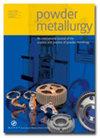Influence of oxygen in the production chain of Cu–Ti-based metallic glasses via laser powder bed fusion
IF 1.9
4区 材料科学
Q2 METALLURGY & METALLURGICAL ENGINEERING
引用次数: 0
Abstract
ABSTRACT Laser powder bed fusion of metals (PBF-LB/M) is advantageous for manufacturing bulk metallic glasses with size and geometrical freedom. However, the oxygen uptake along the production chain can negatively impact the generation of high-quality, amorphous parts. In this context, Cu–Ti-based alloys were gas-atomised and additively manufactured using commercial- (CP) and high-purity (HP) feedstocks. The oxygen absorption in each processing step was tracked and related to the amorphous phase formation and glass-forming ability (GFA) of alloys. Results show an increasing oxygen absorption, considerably influenced by the starting feedstock, especially for CP. In HP material, the most contribution is inherent from the powder oxygen content. Results reveal the lack of influence of the oxygen content in the GFA. TEM analysis of commercial powder and PBF-LB/M sample show uniform and featureless micrographs, displaying the absence of oxygen-induced nucleation. The present contribution enhances the qualification and economic processability of amorphous metals by PBF-LB/M.氧对激光粉末床熔融铜钛基金属玻璃生产链的影响
激光粉末床熔融金属(PBF-LB/M)是制造具有尺寸和几何自由度的大块金属玻璃的有利技术。然而,沿着生产链的氧气摄取会对高质量非晶零件的产生产生负面影响。在这种情况下,cu - ti基合金被气体雾化,并使用商业(CP)和高纯度(HP)原料进行增材制造。跟踪了各加工步骤的氧吸收,并将其与合金的非晶相形成和非晶形成能力(GFA)联系起来。结果表明,氧吸收率增加,很大程度上受起始原料的影响,特别是CP。在HP材料中,最大的贡献来自粉末氧含量。结果表明GFA中氧含量的影响不大。对商品粉末和PBF-LB/M样品的TEM分析显示,样品的显微形貌均匀且无特征,没有氧诱导成核。本研究提高了PBF-LB/M非晶金属的加工质量和经济性能。
本文章由计算机程序翻译,如有差异,请以英文原文为准。
求助全文
约1分钟内获得全文
求助全文
来源期刊

Powder Metallurgy
工程技术-冶金工程
CiteScore
2.90
自引率
7.10%
发文量
30
审稿时长
3 months
期刊介绍:
Powder Metallurgy is an international journal publishing peer-reviewed original research on the science and practice of powder metallurgy and particulate technology. Coverage includes metallic particulate materials, PM tool materials, hard materials, composites, and novel powder based materials.
 求助内容:
求助内容: 应助结果提醒方式:
应助结果提醒方式:


